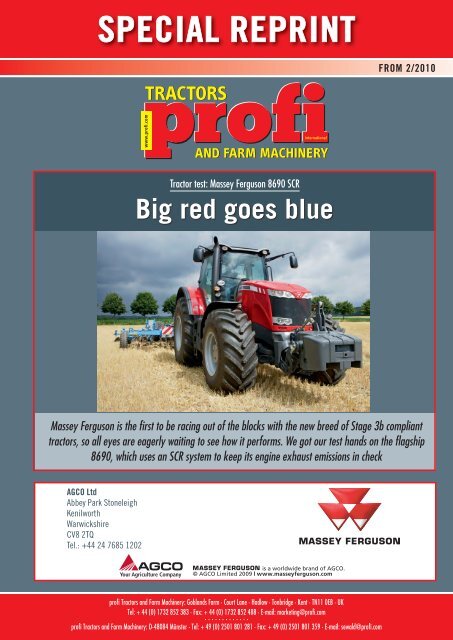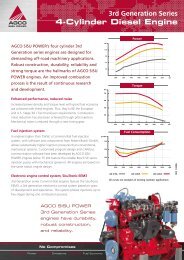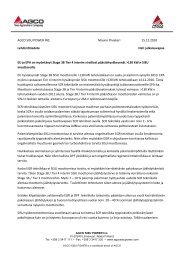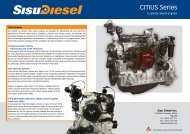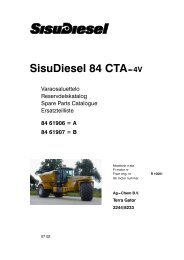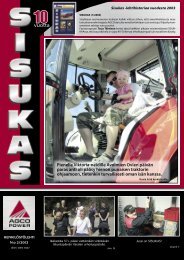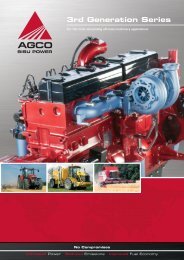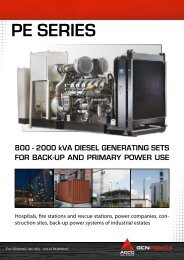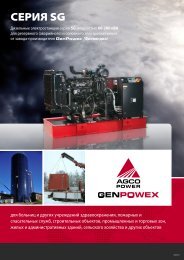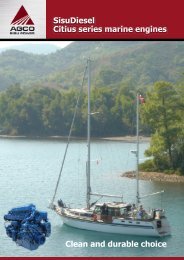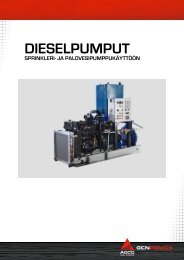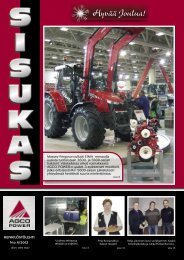Massey Ferguson MF 8690 SCR article - AGCO
Massey Ferguson MF 8690 SCR article - AGCO
Massey Ferguson MF 8690 SCR article - AGCO
You also want an ePaper? Increase the reach of your titles
YUMPU automatically turns print PDFs into web optimized ePapers that Google loves.
SPECIAL REPRINT<br />
FROM 2/2010<br />
Tractor test: <strong>Massey</strong> <strong>Ferguson</strong> <strong>8690</strong> <strong>SCR</strong><br />
Big red goes blue<br />
<strong>Massey</strong> <strong>Ferguson</strong> is the first to be racing out of the blocks with the new breed of Stage 3b compliant<br />
tractors, so all eyes are eagerly waiting to see how it performs. We got our test hands on the flagship<br />
<strong>8690</strong>, which uses an <strong>SCR</strong> system to keep its engine exhaust emissions in check<br />
<strong>AGCO</strong> Ltd<br />
Abbey Park Stoneleigh<br />
Kenilworth<br />
Warwickshire<br />
CV8 2TQ<br />
Tel.: +44 24 7685 1202<br />
is a worldwide brand of <strong>AGCO</strong>.<br />
© <strong>AGCO</strong> Limited 2009 l www.masseyferguson.com<br />
profi Tractors and Farm Machinery: Goblands Farm · Court Lane · Hadlow · Tonbridge · Kent · TN11 0EB · UK<br />
Tel: + 44 (0) 1732 852 383 · Fax: + 44 (0) 1732 852 488 · E-mail: marketing@profi.com<br />
profi x/2007 0C www.profi.com<br />
profi Tractors and Farm Machinery: D-48084 Münster · Tel: + 49 (0) 2501 801 281 · Fax: + 49 (0) 2501 801 359 · E-mail: sewald@profi.com<br />
SD_PI0210_<strong>MF</strong>_Titel.indd 2<br />
14.04.2010 13:06:03 Uhr
PROFI TEST<br />
Tractor test: <strong>Massey</strong> <strong>Ferguson</strong> <strong>8690</strong> <strong>SCR</strong><br />
Big red goes blue<br />
<strong>Massey</strong> <strong>Ferguson</strong> is the first to be racing out of the blocks<br />
with the new breed of Stage 3b compliant tractors, so all<br />
eyes are eagerly waiting to see how it performs. We got<br />
our test hands on the flagship <strong>8690</strong>, which uses an <strong>SCR</strong><br />
system to keep its engine exhaust emissions in check<br />
<strong>Massey</strong>’s <strong>8690</strong> strides into the 300hp<br />
plus arena, bristling with technology that<br />
allows it to sip its way through the red<br />
stuff like nothing we have seen before. In<br />
fact, compared with other tractor models<br />
in our Powermix test league, it swallowed<br />
an impressive 16.6% less fuel per hour,<br />
so that over 1,000 hours the <strong>8690</strong> should<br />
consume 2,000 litres less fuel than the<br />
thirstiest tractor we have tested.<br />
For instance on cultivations it saved 3.3<br />
litres per hectare and 2.8 litres when out<br />
baling: even compared to the average<br />
fuel used in our Powermix test, the <strong>8690</strong><br />
used 1 litre less per hour. Granted, it’s not<br />
all money in the bank, as you need to add<br />
the cost of the AdBlue, which allows the<br />
<strong>8690</strong> to burn fuel more efficiently, mainly<br />
courtesy of Selective Catalytic Reduction<br />
(<strong>SCR</strong>).<br />
For further details on <strong>SCR</strong>, refer back to<br />
previous <strong>article</strong>s in the profi December<br />
2008 and March 2009 issues.<br />
By introducing this Stage 3b technology<br />
now, <strong>Massey</strong> is able to steal a march on<br />
the main competition. With <strong>SCR</strong> fitted, the<br />
engine’s injection sequence has more in<br />
common with motors from the days before<br />
emissions legislation. This is thanks<br />
to an exhaust treatment that dispatches<br />
the nasties and allows fuel injection to<br />
start before the piston reaches top dead<br />
centre, all of which has a positive effect<br />
on fuel consumption.<br />
Purring away under the <strong>8690</strong>’s bonnet is<br />
a six-cylinder, 8.4-litre 84CTA lump from<br />
<strong>AGCO</strong> Sisu Power with common-rail fuel<br />
injection and four valves per pot. <strong>Massey</strong><br />
<strong>Ferguson</strong> claims a rated output of 250kW/<br />
340hp (ISO 14396) and maximum muscle<br />
of 272kW. The <strong>MF</strong> brochure statistics also<br />
usefully provide a maximum pto output of<br />
236kW +/-5%.<br />
In the hands of the DLG test centre our<br />
steed pumped out 220.1kW at the pto<br />
with the motor running at its rated speed<br />
of 2,200rpm. And, as it pulled back to its<br />
maximum output of 1,850rpm, this figure<br />
rose still further – to 244.4kW. Both are<br />
respectable results, although the recorded<br />
drawbar power was 186.3kW at rated<br />
and 207.1kW at maximum speed.<br />
But it is the tractor’s fuel consumption<br />
that attracts particular praise. On the test<br />
bench at rated speed the <strong>8690</strong> managed<br />
to sip 227g/kWh, while at maximum pto<br />
output this dropped down to the best result<br />
we have recorded so far at just 209g/<br />
kWh. Moreover, fuel consumption was<br />
so good throughout typical performance<br />
rates, as well as the Powermix rates, that<br />
the big red was the first tractor to receive<br />
a ‘very good’ in the fuel economy department.<br />
Even if you compare the <strong>8690</strong>’s<br />
stats to the most efficient Stage 3a tractor<br />
we have measured, the <strong>Massey</strong> is still<br />
more efficient – and this statement continues<br />
to hold true after the additional cost<br />
of the liquid urea has been included.<br />
The AdBlue does require its own 30-litre<br />
tank alongside the pair of fuel tanks that<br />
hold a total of 590 litres. Depending on<br />
how hard the tractor is being worked, Ad-<br />
Blue is consumed at a rate of 0.1 to 4.0%<br />
so it usually lasts for about two fills of the<br />
diesel tank.<br />
As a general and reasonably accurate rule<br />
of thumb, the cost of AdBlue is roughly<br />
the same as that of red diesel, but it really<br />
depends on the quantity being bought<br />
and how it is delivered – for example, in<br />
25-litre cans or 1,000-litre IBC tanks. <strong>MF</strong><br />
says that because the product is widely<br />
used in modern trucks, it is readily available<br />
throughout most of Europe.
PROFI TEST<br />
Powermix <strong>Massey</strong> <strong>Ferguson</strong> <strong>8690</strong> <strong>SCR</strong><br />
-20 % -10 % 0 +10 % +20 %<br />
Draft work: Average consumption 255g/kWh and 9.59l/ha<br />
1 Heavy work Plough<br />
(100% Load)<br />
Cultivator<br />
2 Medium Plough<br />
(60% Load)<br />
Cultivator<br />
Pto work: Average consumption 249g/kWh and 3.62l/ha<br />
3 Heavy Power harrow<br />
(100% Load) Mower<br />
4 Medium Power harrow<br />
(70% Load)<br />
Mower<br />
5 Light Power harrow<br />
(40% Load)<br />
Mower<br />
Mixed work: Average consumption 260g/kWh and 3.72l/ha<br />
6 Manure spreader<br />
7 Baler<br />
8 Transport 1)<br />
Powermix 253g/kWh<br />
The Powermix figure is shown at the bottom to the left and is arrived at by averaging the seven individual tests, recorded<br />
over 36 different test runs. The table shows average results for the categories draft work, pto work and mixed work,<br />
measuring fuel consumption in grams per kilowatt hour and in litres per hectare. The yellow line marks the average of all<br />
results obtained from previous Powermix tests. The length of the bars indicates the degree to which tractor performance in<br />
this specific type of work was better (green) or fell short of (red) the average result of all Powermix candidates to date. The<br />
average Powermix result, obtained from the 45 tractors tested to date, currently stands at 303g/kWh.<br />
1) The transport cycle is not available yet.<br />
All Powermix results for the <strong>Massey</strong> <strong>Ferguson</strong> <strong>8690</strong> are better than the average results. In fact the overall consumption<br />
result is 16.6% lower than the average obtained from all previous Powermix tests.<br />
For those thinking that buying in bulk is<br />
the way to go, here’s a couple of words of<br />
warning: AdBlue does have a shelf life,<br />
<strong>MF</strong> <strong>8690</strong> <strong>SCR</strong>: The Dyna-VT infinitely<br />
variable gearbox offers two travel<br />
ranges. One (selectable) StepShift<br />
function simulates 21 powershift steps<br />
Stepless driving<br />
to 50km/hr<br />
Travel range I<br />
Travel range II<br />
-50 -40 -30 -20 -10 0 10 20 30 40 50 km/hr<br />
<strong>MF</strong>’s engine sets new<br />
Powermix standards.<br />
which is linked to how well it is stored,<br />
and the product freezes at -11°C. When<br />
using a tractor in such chilly conditions,<br />
Stepless in the 4-12km/hr range<br />
I<br />
II<br />
0 2 4 6 8 10 12 14 16 18km/hr<br />
N<br />
the tractor’s power is restricted to 70%<br />
until it gets up to temperature, and the<br />
same happens if the operator allows his<br />
AdBlue tank to run low. A small amount<br />
is automatically retained to circulate in<br />
the system and keep the injection nozzle<br />
cooled. On the tractor there is also an Ad-<br />
Blue filter, which needs to be changed<br />
either annually or every 3,600 hours.<br />
Like its predecessor, the 8400 range, the<br />
new <strong>Massey</strong> flagship family is equipped<br />
with a continuously variable speed transmission<br />
and back axle – the same basic<br />
hardware as installed within the Fendt<br />
900 Vario models.<br />
To make the most of this transmission,<br />
<strong>Massey</strong> now uses its full Dynamic Tractor<br />
Management (DTM), allowing for greater<br />
communication between the engine and<br />
gearbox so that the engine speed can automatically<br />
adjust to the load. As well as<br />
being able to choose between its joystick<br />
and pedal driving modes, DTM allows the<br />
operator to set up a trigger. This enables<br />
them to activate DTM automatically when<br />
the pto or a spool valve is engaged or disengaged,<br />
or the linkage is lowered.<br />
Just like its Fendt cousin the speed range<br />
on the <strong>MF</strong> is manually selected. On the<br />
<strong>8690</strong> this is done via a prominent button<br />
on the T-shape transmission joystick, although<br />
we feel it would be much better<br />
if this button was used for the ‘cruise’ and<br />
speed memory.<br />
What is different from the Fendt approach,<br />
and is something that we really like, is<br />
the <strong>MF</strong> operator can individually set the<br />
aggressiveness of direction changes, how<br />
quickly the tractor changes between the<br />
two cruise speeds and the rate of tractor
deceleration when using the pedal mode.<br />
It is possible to set the engine load limit<br />
for pto and other operations.<br />
The <strong>MF</strong> <strong>8690</strong> linkage<br />
offers reasonable<br />
performance. Links<br />
on our test machine<br />
were category III.<br />
Photos: ST.<br />
In drive pedal mode the operator can also<br />
input the top speed setting for both the<br />
low (0-30km/hr) and high (0-50km/hr)<br />
ranges. This setting is done via a dial, but<br />
it is difficult to select a lower rate when<br />
moving without looking at the controller.<br />
To make up for this minor negative, <strong>MF</strong><br />
duplicates the drive pedal functions on<br />
the hand throttle, which is something we<br />
found very useful when baling straw and<br />
carting maize.<br />
Our prototype model only came with two<br />
pto speeds – 540E and 1,000rpm – but we<br />
are told there will be an additional 1,000E<br />
speed available soon. A handy feature is<br />
that the operator can program the external<br />
pto control so that a speed memory is<br />
activated.<br />
Software on our test <strong>8690</strong> was regularly<br />
upgraded during its time with profi, with<br />
continual development to the linkage and<br />
hydraulic system. Linkage operation is the<br />
same as on other <strong>MF</strong> models, and this<br />
<strong>8690</strong> was equipped with a Cat III linkage<br />
as no Cat IV implements were available.<br />
FURTHER DETAILS from our field test<br />
This is not a summary of overall assessments<br />
but a list of positive and less positive details.<br />
Plus<br />
+ Steering wheel offers good<br />
adjustment for all user sizes<br />
+ Effective protection of steps<br />
from dirt contamination<br />
+ Passenger<br />
seat is convenient<br />
and<br />
the ashtray<br />
is magnetmounted<br />
to the<br />
control panel.<br />
— Brake couplers are in an awkward<br />
position for connecting up<br />
— Linkage emergency stop requires<br />
some improvement<br />
— Front linkage top link isn’t practical<br />
+ A photo-voltage element is mounted on the <strong>MF</strong><br />
cab roof. The system maintains the battery voltage.<br />
+ The column-mounted shuttle control can also<br />
adjust the travel speed and operates the accumulated<br />
handbrake (which also controls the trailer).<br />
+ Excellent onboard computer<br />
+ Selectable electric socket<br />
+ Ignition key locks bonnet, fuel<br />
tank cap and doors<br />
Minus<br />
— CBM quick couplers at the back-end<br />
close with difficulty<br />
— Spools are poorly marked<br />
- External control is only for the first spool. The<br />
linkage control response was too slow initially,<br />
and pto control is on the left mudguard only.<br />
- The cooling box stores only one bottle. It is<br />
warmed with the tractor’s heating system.<br />
- The 30-litre<br />
AdBlue tank<br />
mounts on<br />
the left of<br />
the fuel tank,<br />
where it is easy<br />
to access. Yet,<br />
the toolbox is<br />
too small,<br />
mounts too low<br />
and the lock<br />
did not work.
PROFI TEST<br />
The cab is well laid out and clutter-free. Though<br />
different to the 8400 interior, it still has an <strong>MF</strong> feel.<br />
The DLG test station measured a continuous<br />
lift force from the tractor of 8,630daN,<br />
which is a sound result. Not quite so impressive,<br />
however, are the maximum oil<br />
flow at 193.2 litres per minute via three<br />
spools and hydraulic output at 56.3kW;<br />
both figures are average for a tractor in<br />
this power category.<br />
As on other <strong>Massey</strong> <strong>Ferguson</strong> Dyna-VT<br />
models, the hydraulic and transmission<br />
oil is kept separate. Our tractor had a total<br />
of nine spool valves – six on the rear<br />
and three up front – but in standard guise<br />
the <strong>8690</strong> would come with four rear and<br />
Lift capacity (daN)<br />
16,000<br />
14,000<br />
12,000<br />
10,000<br />
8,000<br />
6,000<br />
4,000<br />
2,000<br />
two front spools when a front linkage is<br />
specified. As you might imagine there are<br />
various control systems for operating all<br />
of the spool valves, but some of the operations<br />
are not consistent. For example, for<br />
those activated by the cross controller it is<br />
necessary to pull the lever past a notch to<br />
<strong>Massey</strong> <strong>Ferguson</strong> <strong>8690</strong>: Lift power and lift requirement<br />
5,000kg cultivator drill<br />
Long lift arms: continuous 8,630daN; 81.1cm lift height<br />
Short lift arms continuous 11,400daN; 64.0cm lift height<br />
The armrest with Datatronic CCD looks after a large number of functions.<br />
Certain elements of the ergonomics within the cabin could do with improving,<br />
but overall the accommodation still notches a ‘++’ in our test sheet (p18).<br />
2,000kg plough<br />
0<br />
0 10 20 30 40 50 60 70 80 90 100 110 120<br />
Lift range (cm)<br />
<strong>Massey</strong> <strong>Ferguson</strong> <strong>8690</strong>: The red curve shows the recorded lift capacity (90% of maximum lift) as continuous<br />
lift power on the link ends. The yellow curve displays lift capacity with lift arms shortened – more than<br />
2,770daN extra lift capacity, 17cm smaller lift range. Our <strong>MF</strong> test candidate boasted excellent lift forces.<br />
The tractor’s dashboard is packed with useful<br />
information, even though some of it is duplicated.<br />
engage the timer function<br />
but not when you press it<br />
forward.<br />
The test tractor also came<br />
equipped with a hydraulic<br />
top link, which is becoming<br />
more popular in this<br />
power segment. It can be<br />
operated by the buttons<br />
on either of the rear mudguards,<br />
however this does<br />
mean that the first spool<br />
is tied up by the top link.<br />
Switching attention to the<br />
chassis we find that a slim<br />
waist has allowed for a<br />
tight turning circle. Shod<br />
on 620/75 R30 and 710/85 R38 rubber<br />
with a track width of 194/206cm, our test<br />
<strong>8690</strong> model managed a reasonably compact<br />
13.90m turn – which is tighter than<br />
its competitors. In addition, this all-new<br />
frame has enabled <strong>MF</strong> to move up from<br />
2.05m diameter rear tyres, which were<br />
the limit on the 8480, to 2.15m tall boots<br />
resulting in a bigger footprint for the increased<br />
power.<br />
Up to 2,000kg of extra ballast can also be<br />
added to the rear wheels. Our steed was<br />
wearing 1,000kg of back wheel ballast so<br />
it tipped the scales at 11,700kg. With a<br />
GVWR of 18,000kg, this limited payload to<br />
6,300kg, which is on a par with the other<br />
tractors in this park.<br />
One rather clever feature that has been<br />
developed for the 8600 is the SpeedSteer<br />
function. It allows the operator to set the<br />
number of steering wheel turns from lock<br />
to lock from 0.75 to four. It is a system<br />
that works well but, to prevent accidents,<br />
the feature cannot be used at speeds over<br />
14km/hr; we reckon this limit could be a<br />
little higher.<br />
SpeedSteer can also be incorporated into<br />
the field headland management system:<br />
clever, as highly responsive steering is not
The <strong>MF</strong> <strong>8690</strong>’s integral front linkage is entirely<br />
new, and the operator can make the package<br />
double-acting by simply pressing on a button.<br />
ideal when ploughing. Tractors capable<br />
of a 50km/hr top speed also benefit from<br />
the firm’s front axle suspension system<br />
as standard, although in our view this is<br />
not the most cosseting of packages on the<br />
high-hp market – or at least it wasn’t on<br />
our tested example.<br />
Stepping up into the new four-post cab,<br />
8400 operators will quickly welcome the<br />
28% of extra space but should recognise<br />
the unchanged dash. The new CCD information<br />
display enables the operator to<br />
alter more of the functions and also edit<br />
headland sequences – just as he can on<br />
<strong>MF</strong>’s Datatronic 3 terminal.<br />
The indicator stalk remains on the righthand<br />
side of the steering column, but is<br />
now self-cancelling. The <strong>8690</strong> also gets<br />
hydraulic cab suspension rather than the<br />
pneumatic system, and our test unit came<br />
with Optiride Plus, which not only determines<br />
the current position but responds<br />
to forward speed and pitching, too. On<br />
top of that, the hydraulics can be used to<br />
raise the cab up 17cm to improve access<br />
to the rear axle; as a fringe benefit, this<br />
makes cleaning easier.<br />
Summary: The <strong>MF</strong> 8600 range is the first<br />
in a new generation of catalyst-equipped<br />
machines that will be rolling out of tractor<br />
factories over the next few years. This<br />
technology means the <strong>8690</strong> is Stage 3bready,<br />
an emission standard that does not<br />
come into force until 2011, and perhaps<br />
most impressive of all, when compared to<br />
its current Stage 3a competitors the <strong>8690</strong><br />
stands unrivalled in the economy stakes.<br />
These fuel savings comfortably cover the<br />
cost of using 0.1% to 4% of AdBlue.<br />
The stepless DynaVT transmission, with<br />
its two travel ranges, is an excellent box<br />
that bristles with electronic wizardry. At<br />
the rear, the linkage is strong and the hydraulic<br />
system achieved an average result<br />
for this power bracket. Although the tractor<br />
is running on large rubber to direct all<br />
that power to the ground, it’s surprisingly<br />
manoeuvrable. Indeed our only real area<br />
of criticism was that our test tractor’s suspension<br />
failed to deliver the level of ride<br />
comfort we were expecting. We reckon<br />
some tweaks are required here, although<br />
it could have just been an issue with our<br />
particular test model.<br />
Depending on price, there’s no doubt that<br />
the <strong>MF</strong> <strong>8690</strong> merits serious consideration<br />
in this hp bracket – if for no other reason<br />
than its sector-leading fuel consumption.<br />
List price of the 50km/hr AdBlue-equipped<br />
<strong>8690</strong> is £156,070.<br />
MN, HW
<strong>MF</strong> <strong>8690</strong> <strong>SCR</strong><br />
Technical data<br />
Engine: 250kW/340hp (ISO) at 2,200rpm; max<br />
of 272kW/370hp (ISO); watercooled six-cylinder<br />
(Stage 3b) Sisu 84CTA engine with common-rail,<br />
four valves per cylinder, turbocharger and intercooling;<br />
8,400cm³ capacity; two fuel tanks with<br />
360 + 230 litres; <strong>SCR</strong> catalyst with separate<br />
30-litre AdBlue tank<br />
Transmission: Infinitely variable ‘DynaVT’ with<br />
‘DTM’ management, ML260 from <strong>AGCO</strong>, powershuttle,<br />
automatic shifting; 50km/hr at 1,900rpm<br />
(40km/hr option at 1,600rpm)<br />
Brakes: Wet disc brakes at rear, hydraulic<br />
engagement; parking brake is integrated in<br />
shuttle control; air brake is standard<br />
Electrics: 12V, two batteries; two x 120amp<br />
alternators; 3.6kW/4.9hp starter motor<br />
Linkage: Cat III/IV, ELC with draft link control,<br />
shock absorption and slip control. Front linkage<br />
and pto are optional<br />
Hydraulics: Swash plate pump with 175 litres/<br />
min output, 200 bar, four double-acting spool<br />
valves are standard (max nine); available oil for<br />
external use by towed and mounted implements<br />
is 65 litres<br />
Pto: 540/1,000 or 540E/1,000; 1 3/8in or 1 3/4in,<br />
six or 21 splines, electrohydraulic control<br />
Axles and running gear: Dana front axle with<br />
‘QuadLink’ suspension is standard, <strong>AGCO</strong> HA 260<br />
rear axle, 620/75 R30 and 710/85 R38 test tyres<br />
Service and maintenance: 21 litres engine oil<br />
(400-hour intervals); 85 litres transmission oil<br />
(2,000 hours), 110 litres hydraulic oil (1,200<br />
hours), 34-litre cooling system<br />
Price: 50km/hr base specification model lists at<br />
£156,070 (excl. VAT); front linkage (includes belly<br />
weight and two spools) £4,361 – front pto hikes it<br />
to £7,530; SpeedSteer steering and Datatronic<br />
CCD £3,715 plus AutoGuide with TopDoc £11,562<br />
Output (kW)<br />
300<br />
250<br />
200<br />
150<br />
100<br />
Absolute (l/hr)<br />
75<br />
60<br />
45<br />
30<br />
Output and Torque<br />
Torque (Nm)<br />
Fuel Consumption<br />
kW<br />
Relative (g/kWh)<br />
l/hr<br />
1,200<br />
50<br />
1,000<br />
Nm<br />
0<br />
800<br />
1,000 1,500 2,000 2,500<br />
Engine revs (rpm)<br />
300<br />
15<br />
g/kWh<br />
250<br />
0<br />
200<br />
1,000 1,500 2,000 2,500<br />
Engine revs (rpm)<br />
PROFI TEST<br />
335cm<br />
555cm<br />
Results from the<br />
255cm<br />
test station<br />
Pto output:<br />
Max(1,850rpm)<br />
244.4kW<br />
at rated speed<br />
220.1kW<br />
Fuel consumption:<br />
Specific at max draft output<br />
209g/kWh<br />
Specific at rated speed<br />
227g/kWh<br />
Maximum at rated speed<br />
61.2/59.9l/hr<br />
Torque:<br />
Max<br />
1,432Nm (1,500rpm)<br />
Torque rise 49.9%<br />
Engine speed drop 31.8%<br />
Start-off torque 105%<br />
Transmission:<br />
No. of gears in 4-12km/hr range Stepless<br />
Rear lift power: (90% max oil pressure, corr.)<br />
Bottom<br />
8,630daN<br />
Middle<br />
10,280daN<br />
Top<br />
11,030daN<br />
Lift height under load 81.1cm (23.0-104.1cm)<br />
Hydraulic output:<br />
Operating pressure<br />
220 bar<br />
Max flow<br />
193.2l/min<br />
Max output 56.3kW (177.1l/min, 191 bar)<br />
Drawbar power:<br />
Max (1,850rpm)<br />
207.1kW (248g/kWh)<br />
At rated speed<br />
186.3kW (268g/kWh)<br />
Noise level: (Under load at driver’s ear)<br />
Cab closed/open<br />
Not measured<br />
Braking:<br />
Max mean deceleration<br />
Not measured<br />
Pedal force<br />
Not measured<br />
Turning circle:<br />
4WD disengaged/engaged 13.20m/13.90m<br />
Test weight:<br />
Front axle<br />
4,820kg<br />
Rear axle<br />
6,880kg<br />
Unladen weight (incl. 1t wheel weights) 11,700kg<br />
GVWR<br />
18,000kg<br />
Payload<br />
6,300kg<br />
Power-weight ratio<br />
46kg/kW<br />
Wheelbase<br />
310cm<br />
Track width front<br />
194cm<br />
Track width rear<br />
206cm<br />
Ground clearance<br />
37.3cm<br />
Fuel economy at typical performance<br />
Working areas Output Speed g/kWh l/hr<br />
Standard speed pto 540rpm 100% 2,030 217 61.9<br />
Economy speed pto 540Erpm 100% 1,600 210 57.8<br />
Standard speed pto 1,000rpm 100% 2,030 217 61.9<br />
Economy pto 1,000Erpm 100% – – –<br />
Engine in top speed range 80% Max 231 48.6<br />
High output 80% 90% 218 46.0<br />
Transport work 40% 90% 247 26.0<br />
Low output, 1/2 speed 40% 60% 227 24.0<br />
High output, 1/2 speed 60% 60% 217 34.2<br />
The test results<br />
Engine: ++<br />
Performance characteristics 2.1<br />
Fuel economy 1.0<br />
Pto output/drawbar power 1.5<br />
Best fuel consumption rates. And even though<br />
AdBlue consumption needs to be added, it is still<br />
an excellent result. First-class lugging power.<br />
Transmission: ++<br />
Gearbox ratios/functions 1.0<br />
Shifting 1.6<br />
Clutch/throttle 1.8<br />
Pto 2.5<br />
Excellent CVT transmission with ‘DTM’ management,<br />
50km/hr available at reduced engine<br />
speed. Two travel ranges require manual<br />
engagement; only two pto speeds available.<br />
Chassis: +<br />
Steering 1.5<br />
Four-wheel drive and diff lock 1.8<br />
Hand/foot brake 1.5<br />
Front axle/cab suspension 2.5<br />
Weight and payload 1.5<br />
Manoeuvrable for this power bracket, convenient<br />
‘SpeedSteer’ option. Effective front axle suspension<br />
and hydraulic cab suspension (option).<br />
Nevertheless, driver comfort was disappointing<br />
on our tractor. Payload and ballasting are good.<br />
Linkage/hydraulics: +<br />
Lift power and lift height 1.0<br />
Operation 2.1<br />
Hydraulic output 2.9<br />
Spool valves 3.0<br />
Hydraulic couplers 1.2<br />
Rear lift capacities are very good; hydraulic<br />
output is a good average. Downgraded due<br />
to defects on pre-production machine.<br />
Cab: ++<br />
Space and comfort 1.2<br />
Visibility 1.3<br />
Heating/ventilation 1.6<br />
Noise level<br />
Not measured<br />
Electrical system 2.1<br />
Build quality 2.0<br />
Maintenance 2.3<br />
Very good space and visibility, versatile cab<br />
suspension system. Setting the suspension<br />
system did not have a significant effect.<br />
Ability: – – – o + ++<br />
Basic standards<br />
<br />
Average standards<br />
<br />
High standards<br />
<br />
Field work<br />
<br />
Grassland work<br />
<br />
Transport work<br />
<br />
Loader work<br />
<br />
Price: Low High<br />
£114,000 to £121,000 <br />
Typical farmer buying price after discount excl<br />
VAT for base specification <strong>MF</strong> <strong>8690</strong> (50km/hr)<br />
Grading system: o average<br />
++ very good – – poor<br />
+ good – below average<br />
The individual marks are extracts from our<br />
assessments and do not necessarily result in<br />
a mathematically conclusive overall mark


